 |
 |
 |
 |
Some thoughts from T.U. about some of the rice-paper paintings and prints.
|
 |
 |
 |
|
 |
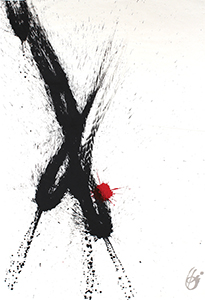 |
1. Within the dimensions of Play. Within the framework of Practice. Practice seen as ways of exploring possibilities of play not constantly caught in the dichotomies of most traditional outcome: this winner, that loser. Play rather as: still in play.
Here, black ink on rice paper, marks by skipping rope. Rope hits paper, placed on ground. Red ink, marks by ball, sent by racquet. Ball hits paper, placed on wall. Grey ink from pen, mark as seal or signature of non-closure. Signature marks paper, placed on board. Sequence of three days in making, wet inks drying.
Rice paper, ink coming from Japan.
|
 |
|
 |
 |
 |
|
 |
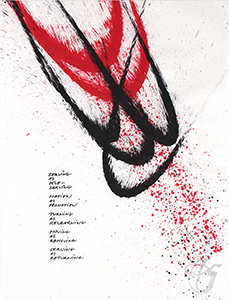 |
2. Inter-play of energies, voices, vectors. Red ink, black ink on rice paper. White ball, from acrylic. Black pen, as marks of text. Grey pen, sealing empty play. Five days in making. Red ink, then black ink from different ropes, again dipped, skipped onto paper lying flat on ground. White ball, hit by racquet, sent horizontally to paper nailed to wall.
Multiple readings, say: habit of serving as self-serving, black rope (subject) desiring to dominate red rope (other), be victorious, come out on top; red ball (object) to be struck, strapped to strategies of the expected; text implying a turning, a facing of play rather than outcome, a relearning: skipping (out of) the dual.
Another reading: playful marks on rice paper.
|
 |
|
 |
 |
 |
|
 |
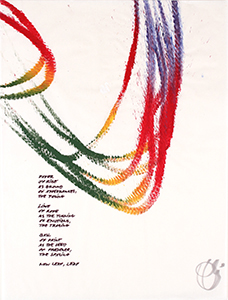 |
3. Rainbow rope: acrylics on rice paper. Spectrum of acrylic colors smeared onto rope. Imprints of practice also in the sense of hour-long skipping with singular rope, slowly marinating, as it were, acrylics into rope, to get smooth (yet reasonably clear) transitions between colors.
Leaping, looping, as playful action: tying, untying connections with Earth (and the other Elements, Water, Fire, Air, Space). Additionally, color scheme (yellow, white, red, green, blue) related to athletic elements as well: firmness (bone, muscle), flexibility (joints, tendons, ligaments), speed (intensities, rates of metabolism), endurance (conditioning, lungs to blood to muscle etc.), fifth element of Space as 'organ of wholeness' (coordinating, integrating agent).
Skipping then again: circular repetition, as non-repetition.
|
 |
|
 |
 |
 |
|
 |
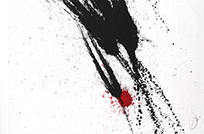 |
4. Black rope on rice paper, red ball. Black and red inks from Japan blending well with Japanese rice paper. Testing other inks; don't work so well. Testing other paper doesn't work well, lesser degrees of absorption. Rope (from boating stores) to be fully dipped day before, then dried, re-dipped on day of action, for every sheet of paper.
Narrow parabola of skipping sometimes on one leg, if no parabola seen: marks from one hand-held rope, following through a serving motion: serving as in initiating, engendering play, but also in sense of preserving what has been initiated, persevering in the playful (differently than the conventionally binary division win/lose).
Again, if read in other ways, say, gender terms, Rorschach style, black strokes of rope may of course be seen as figurations of male and females organs, energies, movement of sperm and so on, red ball as ovum, genesis, growth etc. But don't get stuck.
Main point: ball, lines meeting in joyous, open motion, no splitting, no (final, certified) results.
|
 |
|
 |
 |
 |
|
 |
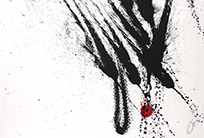 |
5. See note 4. Additionally, black rope marks may be understood as the sequence of possibilities in those mini moments (chronos) of approaching the ball, anticipation now as process, series of micro movements, adjustments, corrections toward the proper moment (kairos), this rightful timing. Even so, as we all know: contingency rules, delightfully.
This applies maybe a little more so with respect to ball here dipped in red. Held in hands with gloves already unevenly smeared in drying ink, ball may be semi-glued to gloves when tossed up to be volleyed (distance of two to three yards) toward rice paper already nailed to wall, making toss and hit a bit extra unpredictable (compared to feel of naked hand and un-inked ball).
But again: leaps of play.
|
 |
|
 |
 |
 |
|
 |
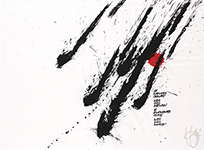 |
6. See notes 4 and 5. Additionally, there's a text here (unlike 4 and 5) speaking of memory and awareness, two notions easily getting in the way of each other. Memory may mean a full house, windows (of senses, sensibilities) curtained or closed by piles of storage, files of notations (identity, rank, scores), lingering ambitions, old bandages, unhealed wounds etc. Leaving less or little space for heightened attention, for situation actually at hand.
Who's there (asks the text)? Maybe no-who: fully attentive, radiant awareness not in need of an owner.
|
 |
|
 |
 |
 |
|
 |
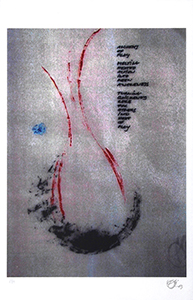 |
7. Alchemy of Play, says the text. Here the image, a print, still on rice paper, to be seen perhaps a little more figuratively from the start: red acrylic lines (and black contour) forming traditional alchemical container, flask or alembic, in which transmutations are undertaken, set in motion: outlined here by red edges of racket frame – frame and strings of racket (like container, flask) holding ball momentarily within itself, de-stilling it into possibilities of dynamic play, risky, enriching, transformative.
Or, container, flask may be seen, firstly, as image of our body itself, grosser body fine-tuning itself toward athletic body, then perhaps fine-tuning itself further in terms of more subtle states (breath, awareness): integrating, integrated slowly, existentially.
Blue acrylic ball (again, not placed or pasted on; volleyed from distance, seal of chance), pointing to element of Space. Also relates to text, where it speaks of 'keen awareness': two terms, space and awareness, showing up together, being undivided from the beginning, continuum of appearance/nothingness.
As for procedure into print, see Note 8.
|
 |
|
 |
 |
 |
|
 |
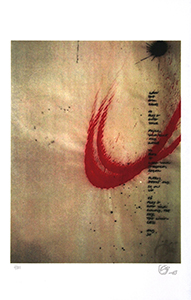 |
8. Print on rice paper, signed and numbered. Initial work, also on rice paper (see notes 1 and 2).
Printing procedure itself: initial rice paper photographed, then taken to Kinko's, copy and printing chain, an outlet of theirs in Seattle, where dear artist friend Monika Lidman, working there at the time (2003), offered to help. Photographed image of initial rice paper placed in Kinko computer printing machinery, Monica orchestrating improvised, maybe random, pushing of buttons, first under her guidance, then taking turns (also within singular printouts): interplay, fun (field's where you find it).
A way of seeing this particular composition, in terms of relationship between rope and text: viewed from above, red rope as curved line of swing, say, forehand, backhand or contemporary large volley motion, hitting down toward bottom of paper, line of text serving as axis for swing.
Going along with this reading, may raise question: how come ball at top appears behind swing? Possible answer: Player who swung missed. Happens.
Regarding color variations in brownish background, lighter patches as if radiating from red parabolas: initial impact of ink from rope bleeding out into rice paper, now slowly drying, and in process pulling up paper, sort of shrinking it, making paper wavy, uneven, adding perhaps dynamic sense of space.
|
 |
|
 |
 |
 |
|
 |
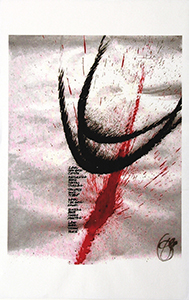 |
9. Print on rice paper. Black, red ink on rope, white acrylic on ball (near top of red ink link rope line). Printing process as before (see note 8). Text speaks of 'when the ball comes', pointing perhaps at first to playing field at hand, any size field, any shape ball; secondly, then metaphorically extended, to larger walks of life, where application of athletic language seems normative: as everyday way of reducing most everything into clear, binary oppositions.
Text then speaks of turning, returning, suggesting step back: letting play stay in play.
|
 |
|
 |
 |
 |
|
 |
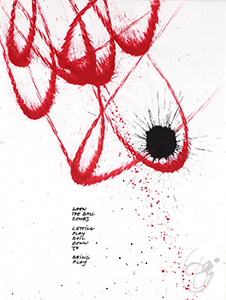 |
10. Red ink on rope, white rice paper, black ink on text, ball. Again, play as Alchemical Theater. Various colors as stages of (performative, peaceful) process.
This time (unlike above, see note 7) read in reverse: grey color of signature (persona in time and space) as starting point, moment of actual move in deeper felt need toward change, early stages of yielding selfhood, opening up, burning barriers, hence a blackening, signifying a dying to dualities, set in motion as dissolving, then coagulating, again and again (opus circulatorium); radiant ball as Black Sun (sol niger), coming toward full-blown stage of nigredo, black text speaking of 'boiling down' implying also a firing up, distilling, slowly, into whiteness, chemical wedding, embraces, white and red elements conjoined, red tincture (on ropes, on paper) as imprints or trackings: toward the fields of Elixir, toward the Stone.
|
 |
|
 |
 |
 |
|
 |
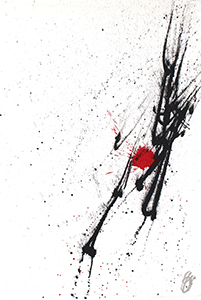 |
11. Imprints of practice. Practice as continuum. Continuum as (1) staying on, within framework of certain field of expression, or (2) staying on, within framework of certain principles, guidelines, but shifting into a different field of expression. More explicit difference between (1) and (2) would be, say, going from music to architecture. Smaller step would mean staying within field, say ink on rice paper, but shifting, as here, from something predominantly skipped, to something thrown: marks at end of movement, swing, but not involving leaps of feet.
Still bearing in mind: leap as small fired-up moment, leaving space between earth and air; fluidity, flexibility as element of water, when ball of foot, bended knees reconnect with ground.
Again, more figuratively: narrowing of skipped parabola, closer to cluster of singular lines, folded rope now thrown. Throwing movement as swing, as fuller swing of serving motion. Serving not only as initiating play (like calling out in olden days, as in French for 'Hold it', or 'Attention': Tenez!). Serving also as continuum, as ongoing, durational, friendly attention, serving play, serving fellow players, serving fellow beings, serving ending warfare, and further, no end.
|
 |
|
 |
 |
 |
|
 |
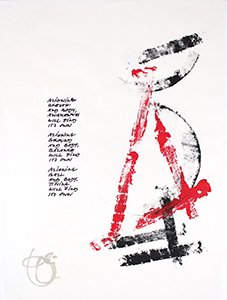 |
12. Acrylics on rice paper, smeared racquet grip and frame, black and red. Ball, in blue acrylic (barely visible), element of space.
The Elements, again (see note 3). This time seen, stupa-style, through lens of Buddhist iconography, describing awakened energies, architecture as non-dual body, rising, from earth or ground on up, in terms of density, grosser to very subtle. Earth taking form in squares, the rectangular; Water seen as flowing in the circular; Fire as triangular, flames of locus-born heat burning, through, to and from lineages of wisdom-knowledge; Air as half circle, unending wind of workless work; Space as great void, wakefulness rising as simultaneously empty and radiantly open, awareness appearing as, say, wholly non-attached, yet fully there, attentive, in both eye and breath of compassion.
This challenging manifestation, as still traditional architecture, attempted here taken down into present humble plane: now out of its completed balance, into more mundane configurations, bodies of athletes, musicians of the muscular, breathers of yogic aspirations, of shamanic inclinations, of chemical weddings, sisters and brothers still spelled by ironies of play, still trying to milk sky, for the blood of being…
|
 |
|
 |
 |
 |
|







